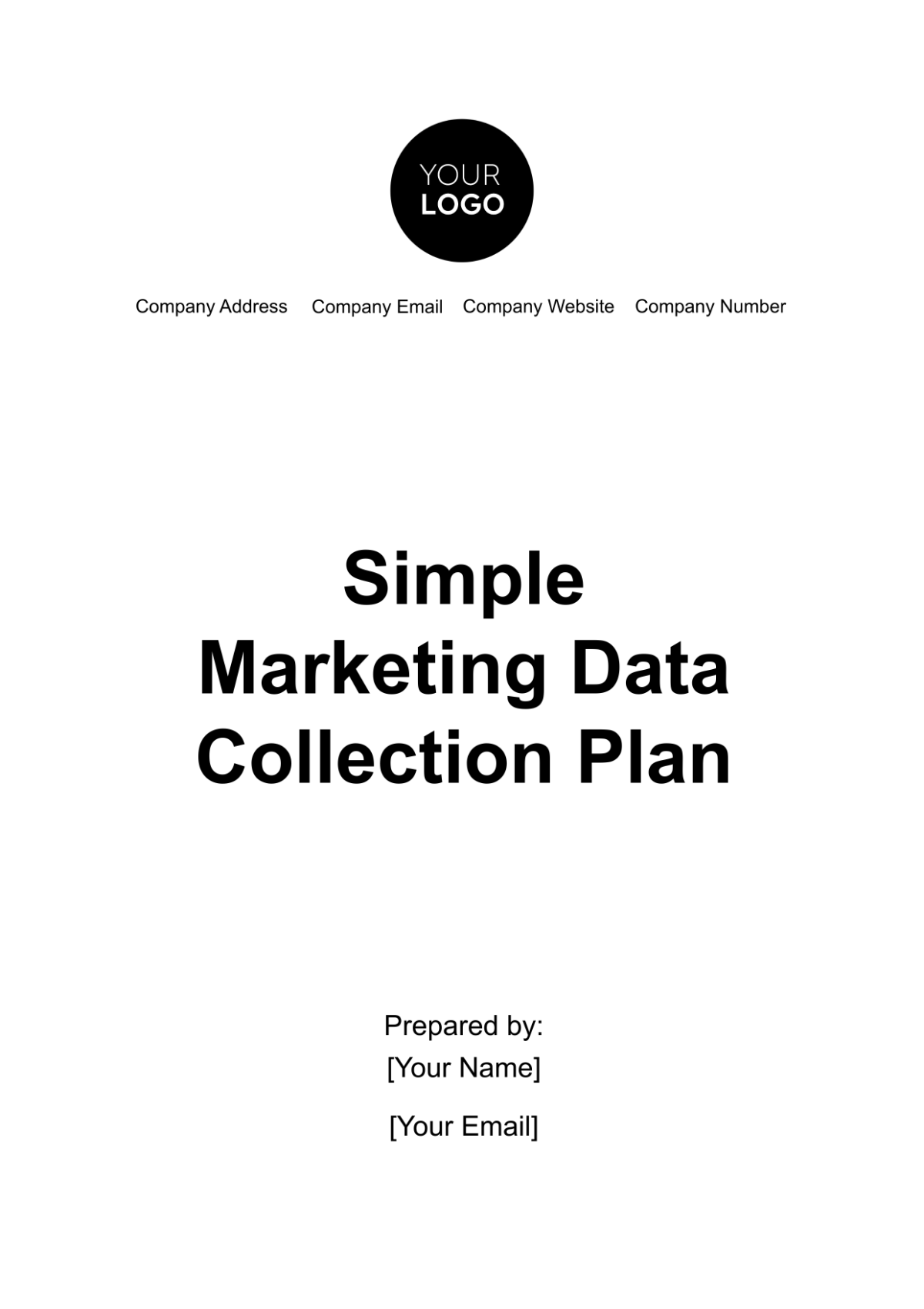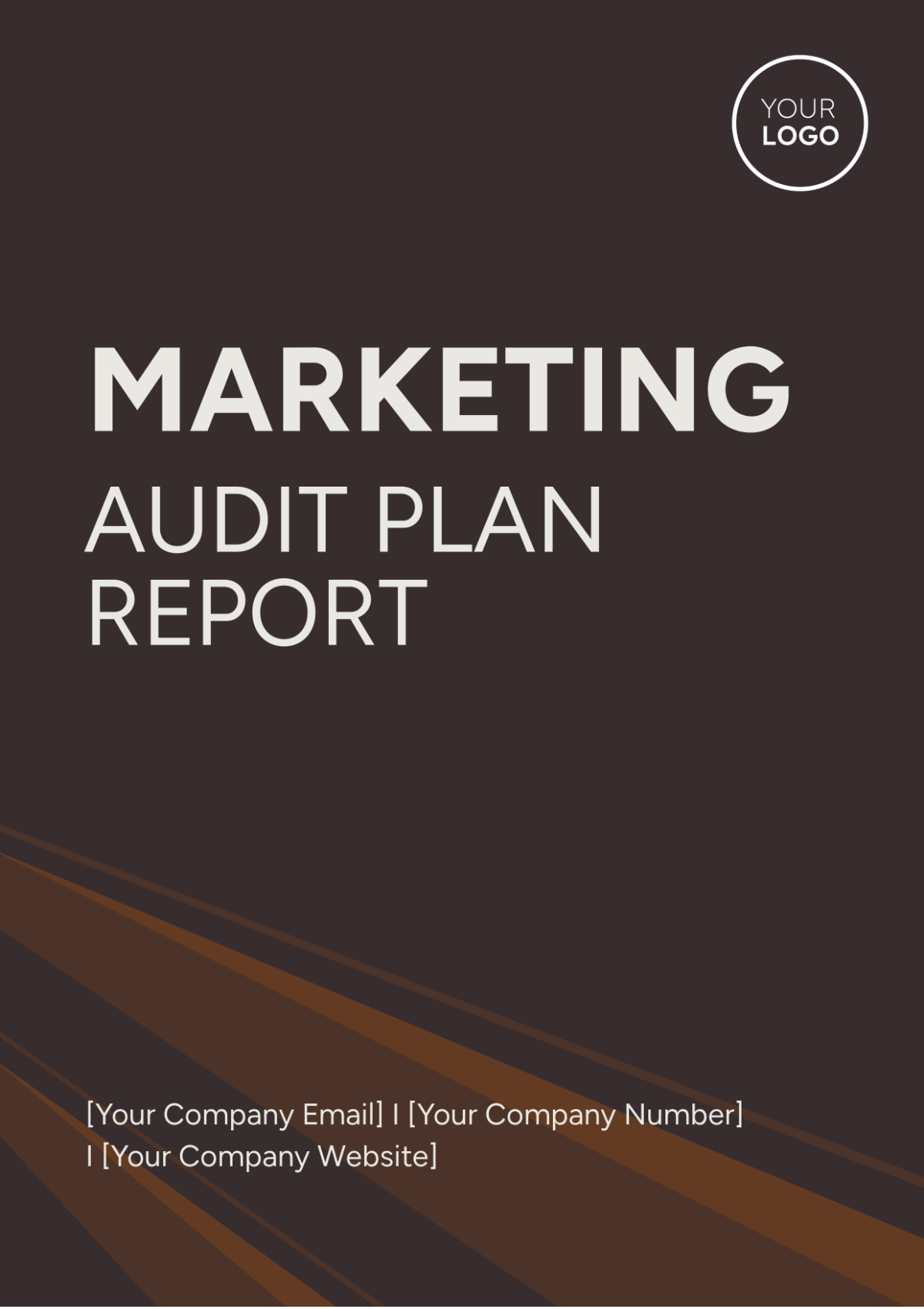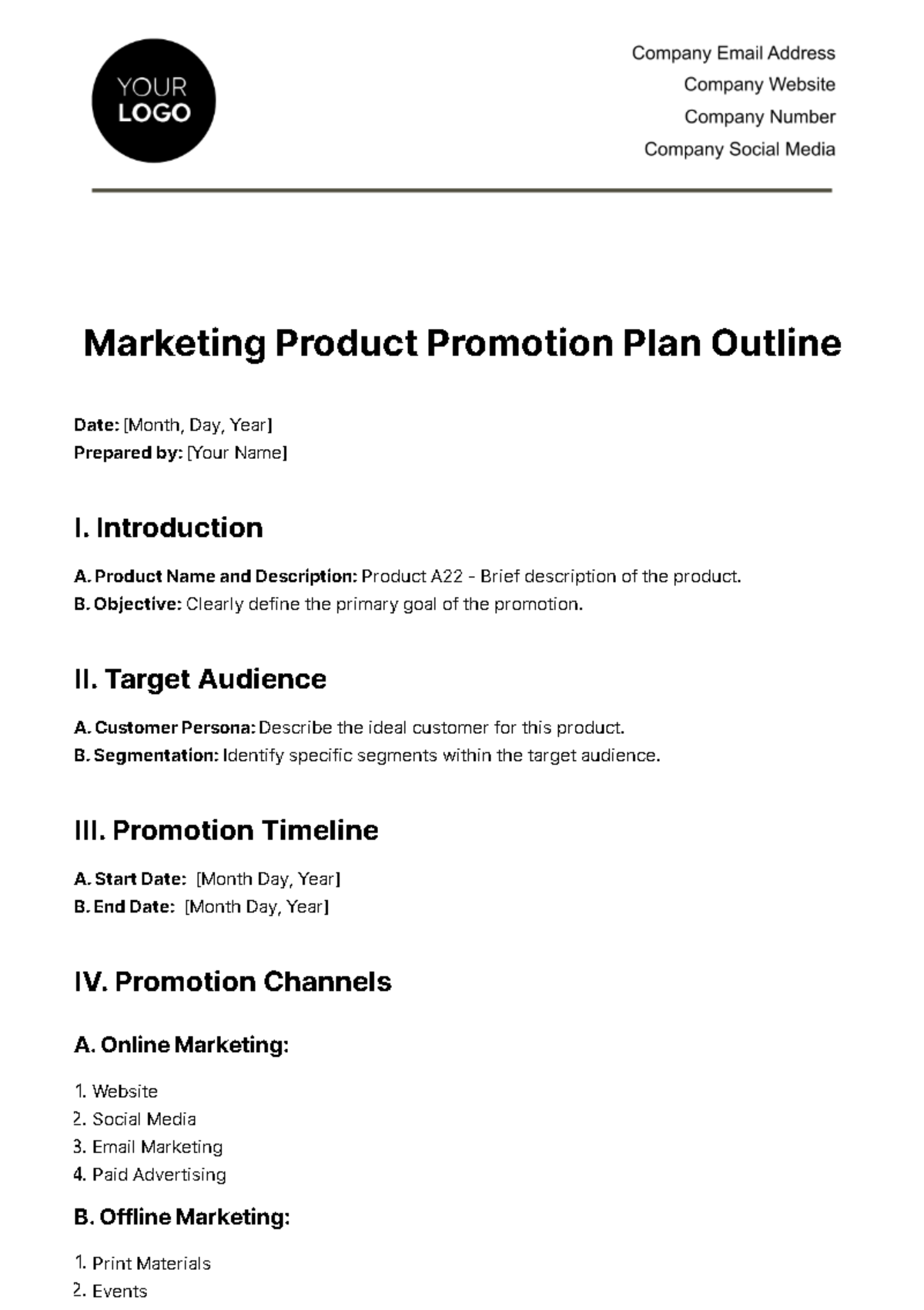Simple Marketing Data Collection Plan
I. Introduction
A. Overview
1. Purpose of the Plan
The Marketing Data Collection Plan is a strategic document designed to outline the procedures and methodologies for gathering data relevant to [Your Company Name]'s marketing efforts. This plan serves as a roadmap for systematically collecting and analyzing data to inform and enhance marketing strategies. By clearly defining the objectives and methods for data collection, the plan ensures that [Your Company Name] can make well-informed decisions that drive business growth. It provides a structured approach to data collection, helping to align marketing activities with organizational goals and ensuring that data is collected in a consistent and reliable manner.
2. Importance of Data Collection
Effective data collection is fundamental to the success of any marketing strategy. It allows [Your Company Name] to gain a comprehensive understanding of market dynamics, customer preferences, and the performance of marketing campaigns. By analyzing data, the company can identify trends, measure the impact of marketing activities, and make evidence-based decisions. Data collection also helps in segmenting the target audience, optimizing marketing efforts, and improving overall customer engagement. In an increasingly competitive market, leveraging data provides a strategic advantage by enabling [Your Company Name] to respond proactively to changing market conditions and customer needs.
3. Scope of the Plan
The scope of this plan encompasses all aspects of data collection related to [Your Company Name]'s marketing activities. This includes identifying the types of data to be collected, selecting appropriate methods and tools, defining roles and responsibilities, and establishing data management procedures. The plan applies to various marketing initiatives, including advertising campaigns, customer surveys, social media monitoring, and market research. It is intended to be a comprehensive guide that covers the entire data collection process, from planning and execution to analysis and reporting.
B. Objectives
1. Define Clear Goals
One of the primary objectives of the Marketing Data Collection Plan is to establish clear and measurable goals for data collection efforts. This involves setting specific objectives that align with [Your Company Name]'s marketing strategies and overall business goals. For example, goals may include increasing customer acquisition rates, improving brand awareness, or enhancing customer satisfaction. By defining clear goals, the company can focus its data collection efforts on obtaining information that directly contributes to achieving these objectives. Clear goals also facilitate the evaluation of data collection activities and help measure their success.
2. Ensure Data Accuracy
Ensuring the accuracy of collected data is critical to obtaining reliable insights and making informed decisions. The plan outlines procedures for verifying data accuracy and minimizing errors during the data collection process. This includes implementing quality control measures, such as data validation checks and regular audits, to identify and correct any discrepancies. Accurate data is essential for generating trustworthy insights and avoiding misinterpretations that could lead to incorrect conclusions or ineffective marketing strategies.
3. Facilitate Data-Driven Decision Making
The ultimate goal of data collection is to support data-driven decision-making processes at [Your Company Name]. By providing actionable insights and reliable information, the plan helps decision-makers make informed choices that are based on empirical evidence rather than intuition alone. Data-driven decision-making enables the company to optimize marketing strategies, allocate resources efficiently, and measure the effectiveness of various initiatives. It also enhances the ability to identify opportunities for growth and address potential challenges proactively.
II. Data Collection Framework
A. Types of Data
1. Quantitative Data
Quantitative data refers to numerical information that can be measured and analyzed using statistical methods. This type of data is essential for identifying trends, patterns, and relationships within the dataset. Examples of quantitative data include sales figures, website traffic statistics, and customer survey responses. Quantitative data provides objective and quantifiable insights that can be used to track performance metrics, evaluate the success of marketing campaigns, and make comparisons across different segments or time periods.
2. Qualitative Data
Qualitative data involves descriptive information that provides deeper insights into customer attitudes, perceptions, and experiences. Unlike quantitative data, qualitative data is not easily measured or quantified but offers valuable context and understanding. Examples of qualitative data include customer feedback, interview transcripts, and focus group discussions. This type of data helps [Your Company Name] gain a richer understanding of customer motivations, preferences, and pain points, which can inform the development of more targeted and effective marketing strategies.
3. Primary Data
Primary data is information collected directly from original sources through various methods such as surveys, interviews, and observations. This type of data is specific to [Your Company Name]'s research needs and provides firsthand information about customers, market conditions, and marketing performance. Collecting primary data allows the company to address specific research questions and obtain relevant and current information that is directly applicable to its marketing objectives.
4. Secondary Data
Secondary data refers to information that has been previously collected and published by other sources. This includes industry reports, market studies, and public databases. Secondary data can provide valuable context and background information that complements primary data. It is often used to supplement primary research, identify trends and benchmarks, and gain insights into broader market dynamics. Leveraging secondary data can help [Your Company Name] build a comprehensive understanding of the market and inform its data collection efforts.
B. Data Collection Methods
1. Surveys and Questionnaires
Surveys and questionnaires are commonly used methods for collecting both quantitative and qualitative data. They can be distributed through various channels, including online platforms, mail, or in-person. Designing effective surveys involves crafting clear and unbiased questions that capture relevant information while minimizing respondent bias. Surveys can provide valuable insights into customer preferences, satisfaction levels, and opinions about products or services. Online survey tools offer features such as automated data collection and real-time reporting, making it easier to analyze and interpret survey results.
2. Interviews
Interviews provide an opportunity to gather in-depth insights from individuals or groups. They can be conducted in person, over the phone, or via video conferencing. Interviews can be structured, semi-structured, or unstructured, depending on the research objectives and the level of detail required. Structured interviews involve asking a set of predetermined questions, while semi-structured and unstructured interviews allow for more flexibility and exploration of topics. Effective interviews require careful preparation, including developing an interview guide, establishing rapport with participants, and actively listening to their responses.
3. Focus Groups
Focus groups involve facilitating group discussions to explore specific topics or issues in depth. A trained moderator guides the discussion and encourages participants to share their opinions and experiences. Focus groups are useful for gaining qualitative insights into customer attitudes, perceptions, and behaviors. Selecting a diverse group of participants and creating a comfortable environment for open dialogue are essential for obtaining valuable feedback. Focus groups can help identify common themes, generate new ideas, and understand the dynamics of group interactions.
4. Observations
Observations involve monitoring and recording behaviors and interactions in natural settings. This method can provide valuable context and insights that may not be captured through other data collection methods. Observations can be structured, where specific behaviors or events are recorded, or unstructured, where the observer takes a more general approach. It is important to observe ethically, respecting participants' privacy and ensuring that observations are conducted systematically and without bias. Observational data can complement other data sources and provide a deeper understanding of customer behavior.
5. Social Media Analytics
Social media analytics involves analyzing data from social media platforms to gain insights into customer sentiment, engagement, and trends. This includes monitoring mentions, interactions, and content performance across various social media channels. Social media analytics tools can provide real-time data, sentiment analysis, and trend tracking, helping [Your Company Name] understand how its brand is perceived and how customers are engaging with its content. Analyzing social media data can inform content strategy, identify key influencers, and measure the impact of social media campaigns.
6. Web Analytics
Web analytics involve tracking and analyzing website traffic, user behavior, and online interactions. This includes metrics such as page views, bounce rates, conversion rates, and user flow. Web analytics tools provide valuable insights into how visitors interact with [Your Company Name]'s website, including which pages are most popular, where visitors are coming from, and how they navigate through the site. By analyzing web analytics data, the company can optimize its website design, improve user experience, and enhance online marketing efforts.
C. Data Collection Tools
1. Survey Tools
Survey tools such as SurveyMonkey, Google Forms, and Qualtrics facilitate the creation, distribution, and analysis of surveys. These tools offer various features, including customizable templates, automated data collection, and detailed reporting capabilities. Using survey tools streamlines the data collection process, making it easier to reach a large number of respondents and gather valuable feedback. Additionally, these tools provide analytics features that help in analyzing survey results and generating actionable insights.
2. Interview Recording Devices
Recording devices, such as digital recorders or mobile apps, can be used to capture interview responses accurately. Recording interviews allows for precise documentation of participant responses, which can be transcribed and analyzed later. It is important to obtain consent from participants before recording and ensure that recordings are securely stored to protect participant privacy. Proper handling and storage of interview recordings are essential for maintaining data integrity and confidentiality.
3. Focus Group Software
Focus group software, such as FocusVision or Zoom, assists in conducting virtual focus groups and managing discussions. These tools offer features such as video conferencing, chat functions, and real-time data capture. Virtual focus group software enables [Your Company Name] to reach participants from different locations and conduct discussions efficiently. The software also provides tools for recording and analyzing focus group sessions, helping to capture valuable insights and feedback.
4. Social Media Monitoring Tools
Social media monitoring tools like Hootsuite, Brandwatch, and Sprout Social help in tracking and analyzing social media activity. These tools provide features such as sentiment analysis, trend tracking, and engagement metrics. By monitoring social media platforms, [Your Company Name] can gain insights into customer sentiment, identify emerging trends, and measure the impact of social media campaigns. Social media monitoring tools also help in managing online reputation and responding to customer feedback promptly.
5. Web Analytics Platforms
Web analytics platforms such as Google Analytics, Adobe Analytics, and Matomo provide detailed insights into website performance and user behavior. These platforms offer features for tracking website metrics, analyzing user interactions, and generating reports. Web analytics platforms help [Your Company Name] understand how visitors interact with its website, identify areas for improvement, and optimize online marketing strategies. By leveraging web analytics data, the company can enhance user experience and drive better results from its online presence.
III. Data Collection Procedures
A. Planning
1. Develop a Data Collection Plan
Creating a detailed data collection plan involves outlining the objectives, methods, and tools for collecting data. This plan should specify the types of data to be collected, the target audience, and the timeline for data collection activities. It is important to identify the key research questions and determine how the data will be used to inform marketing decisions. A well-developed data collection plan ensures that all aspects of the process are covered, from initial planning to data analysis and reporting.
2. Define Roles and Responsibilities
Clearly defining roles and responsibilities ensures that all team members involved in data collection understand their tasks and obligations. This includes assigning responsibilities for designing data collection instruments, recruiting participants, administering surveys or interviews, and analyzing data. Establishing clear roles helps to streamline the data collection process and ensures that each aspect of the process is managed effectively. Communication and coordination among team members are essential for successful data collection and management.
3. Develop a Timeline
Creating a timeline for data collection activities helps to ensure that the process is organized and completed within the desired timeframe. The timeline should include key milestones, such as the development of data collection instruments, recruitment of participants, data collection periods, and analysis deadlines. It is important to consider potential challenges and allow for flexibility in the timeline to accommodate any unforeseen issues. A well-planned timeline helps to keep the data collection process on track and ensures timely delivery of results.
B. Data Collection
1. Implement Data Collection Methods
Executing the chosen data collection methods involves carrying out the planned activities according to the established procedures. This includes administering surveys, conducting interviews, facilitating focus groups, and performing observations. It is important to follow the guidelines and protocols outlined in the data collection plan to ensure consistency and reliability. Proper implementation of data collection methods helps to obtain accurate and relevant information that meets the research objectives.
2. Monitor Data Collection Progress
Regular monitoring of data collection progress is essential for identifying any issues or deviations from the plan. This involves tracking the completion rates of surveys, ensuring that interviews are conducted as scheduled, and reviewing the quality of collected data. Monitoring progress allows for timely adjustments to address any challenges and ensure that data collection activities are on track. It also helps to maintain data quality and integrity throughout the collection process.
3. Address Issues and Challenges
Addressing issues and challenges that arise during data collection is crucial for maintaining the effectiveness of the process. This includes resolving any problems related to data collection methods, participant recruitment, or data quality. It is important to have contingency plans in place to handle unexpected issues and minimize their impact on the data collection process. Promptly addressing challenges helps to ensure that the data collected is accurate and reliable.
C. Data Management
1. Data Storage
Storing collected data securely is essential for protecting its confidentiality and integrity. This involves implementing appropriate measures for data storage, such as using encrypted databases or secure cloud storage solutions. It is important to establish protocols for data access and ensure that only authorized individuals can view or modify the data. Proper data storage practices help to safeguard sensitive information and prevent unauthorized access or data breaches.
2. Data Cleaning
Data cleaning involves reviewing and correcting collected data to ensure its accuracy and completeness. This includes identifying and addressing any errors, inconsistencies, or missing values in the dataset. Data cleaning helps to improve the quality of the data and ensure that it is suitable for analysis. Techniques such as data validation, error checking, and imputation can be used to clean the data effectively. Regular data cleaning processes help to maintain the reliability and usability of the dataset.
3. Data Security
Ensuring data security is critical for protecting sensitive information and maintaining compliance with data protection regulations. This includes implementing security measures such as encryption, access controls, and regular security audits. It is important to follow best practices for data security and stay informed about potential threats or vulnerabilities. Data security measures help to prevent unauthorized access, data breaches, and other security risks that could impact the integrity of the collected data.
IV. Data Analysis
A. Analyzing Quantitative Data
1. Statistical Analysis
Statistical analysis involves applying mathematical techniques to analyze numerical data and identify patterns or relationships. This includes calculating descriptive statistics such as mean, median, and standard deviation, as well as conducting inferential statistics such as regression analysis or hypothesis testing. Statistical analysis helps to summarize and interpret quantitative data, providing insights into trends, correlations, and the impact of various factors on marketing performance.
2. Data Visualization
Data visualization involves presenting data in graphical formats, such as charts, graphs, and tables, to make it easier to understand and interpret. Effective data visualization helps to highlight key findings, identify trends, and communicate insights to stakeholders. Tools such as Tableau, Power BI, and Excel can be used to create visually appealing and informative data visualizations. By presenting data in a clear and accessible manner, data visualization enhances the ability to make data-driven decisions and share insights with others.
B. Analyzing Qualitative Data
1. Thematic Analysis
Thematic analysis involves identifying and analyzing patterns or themes within qualitative data. This includes coding the data, grouping related codes into themes, and interpreting the findings. Thematic analysis helps to uncover underlying meanings and insights from qualitative data, providing a deeper understanding of customer attitudes, perceptions, and experiences. It is important to approach thematic analysis systematically and ensure that the findings are grounded in the data.
2. Content Analysis
Content analysis involves systematically analyzing textual or visual content to identify patterns, trends, and meanings. This includes coding and categorizing content, examining frequency and context, and interpreting the results. Content analysis helps to understand the content's message, tone, and impact, providing insights into customer sentiment, brand perception, and communication effectiveness. It is useful for analyzing qualitative data from sources such as social media posts, customer reviews, and focus group discussions.
C. Reporting
1. Create Data Reports
Data reports summarize and present the findings from data analysis in a structured and coherent format. Reports should include an overview of the objectives, methods, and results, as well as visualizations and interpretations of the data. It is important to tailor the report to the intended audience, focusing on key insights and actionable recommendations. Data reports help stakeholders understand the implications of the data and make informed decisions based on the findings.
2. Share Insights with Stakeholders
Sharing insights with stakeholders involves communicating the results of data analysis to relevant parties, such as marketing teams, executives, and other decision-makers. This includes presenting findings in meetings, distributing reports, and providing recommendations for action. Effective communication of insights helps to ensure that data-driven decisions are made based on the analysis and that the findings are used to inform and improve marketing strategies. It is important to highlight key insights and address any questions or concerns from stakeholders.
V. Compliance and Ethics
A. Data Privacy
1. Adhere to Data Protection Regulations
Compliance with data protection regulations is essential for ensuring that data is collected, stored, and used in accordance with legal and ethical standards. This includes adhering to regulations such as the General Data Protection Regulation (GDPR) and the California Consumer Privacy Act (CCPA). It is important to understand and implement the requirements of these regulations, including obtaining consent from participants, providing transparency about data usage, and ensuring data security. Adhering to data protection regulations helps to maintain trust and avoid legal or reputational risks.
2. Obtain Informed Consent
Obtaining informed consent involves ensuring that participants are fully aware of the purpose, procedures, and potential risks of data collection before they provide their information. This includes providing clear and detailed information about how their data will be used and obtaining their explicit consent. Informed consent helps to protect participants' rights and ensure that they participate voluntarily and with full understanding. It is important to document consent and ensure that participants have the option to withdraw their consent at any time.
B. Ethical Considerations
1. Respect Participants' Privacy
Respecting participants' privacy involves handling their data with confidentiality and sensitivity. This includes protecting personal information from unauthorized access, ensuring that data is used only for its intended purpose, and minimizing any potential harm to participants. Ethical data collection practices help to build trust and maintain positive relationships with participants. It is important to follow ethical guidelines and best practices to ensure that data collection is conducted responsibly and respectfully.
2. Ensure Data Accuracy and Integrity
Ensuring data accuracy and integrity involves maintaining the quality and reliability of collected data throughout the collection and analysis processes. This includes implementing quality control measures, verifying data accuracy, and addressing any issues that arise. Accurate and reliable data is essential for making informed decisions and achieving meaningful insights. Upholding data integrity helps to ensure that the findings are valid and that the conclusions drawn from the data are based on accurate information.
VI. Evaluation and Improvement
A. Performance Metrics
1. Measure Data Collection Effectiveness
Measuring the effectiveness of data collection involves assessing how well the data collection methods and processes have achieved the objectives outlined in the plan. This includes evaluating the quality, completeness, and relevance of the collected data, as well as the efficiency of the data collection procedures. Performance metrics such as response rates, data accuracy, and timeliness of data collection can provide insights into the effectiveness of the data collection efforts. Regular evaluation helps to identify areas for improvement and ensure that data collection practices are optimized.
2. Analyze Results Against Objectives
Analyzing results against objectives involves comparing the outcomes of data collection with the initial goals and objectives outlined in the plan. This includes assessing whether the data collected has provided the necessary insights and information to support decision-making and achieve marketing objectives. By analyzing results in relation to objectives, [Your Company Name] can determine the success of the data collection efforts and identify any gaps or areas for improvement. This analysis helps to refine data collection strategies and enhance the effectiveness of future data collection activities.
B. Continuous Improvement
1. Identify Areas for Improvement
Identifying areas for improvement involves reviewing the data collection process and outcomes to pinpoint any weaknesses or challenges. This includes evaluating the effectiveness of data collection methods, tools, and procedures, as well as gathering feedback from stakeholders and participants. By identifying areas for improvement, [Your Company Name] can make necessary adjustments to enhance the data collection process and ensure that future efforts are more efficient and effective.
2. Implement Changes
Implementing changes involves making adjustments to the data collection plan and procedures based on the identified areas for improvement. This may include updating data collection methods, revising survey questions, or adopting new tools and technologies. Implementing changes helps to address any issues and enhance the overall quality and effectiveness of data collection efforts. It is important to monitor the impact of these changes and continue to refine the data collection process to achieve optimal results.
VII. Conclusion
A. Summary of Key Points
The Marketing Data Collection Plan provides a comprehensive framework for systematically gathering and analyzing data to support [Your Company Name]'s marketing strategies. Key components of the plan include defining clear objectives, selecting appropriate data collection methods, ensuring data accuracy and security, and analyzing results to inform decision-making. By following the outlined procedures and best practices, [Your Company Name] can effectively collect and utilize data to enhance its marketing efforts and achieve business goals.
B. Future Considerations
As [Your Company Name] continues to evolve and adapt to changing market conditions, it is important to regularly review and update the data collection plan. Future considerations may include exploring new data collection methods, adopting emerging technologies, and addressing evolving data privacy regulations. Staying informed about industry trends and advancements in data collection practices will help [Your Company Name] maintain a competitive edge and ensure that its data collection efforts remain effective and relevant.
C. Final Thoughts
A well-structured and comprehensive Marketing Data Collection Plan is essential for driving data-driven decision-making and achieving marketing success. By implementing the plan and adhering to best practices, [Your Company Name] can gather valuable insights, optimize marketing strategies, and achieve its business objectives. Data collection is an ongoing process that requires careful planning, execution, and evaluation. Embracing a systematic approach to data collection will help [Your Company Name] harness the power of data to drive growth and achieve long-term success.






























